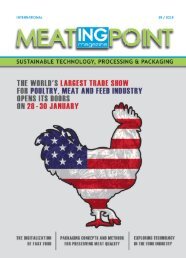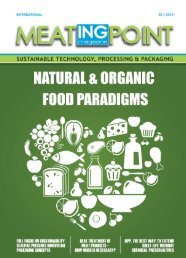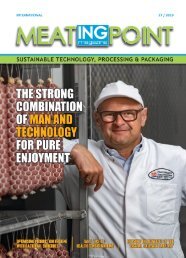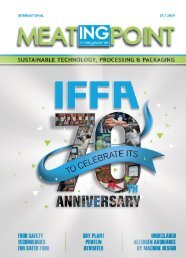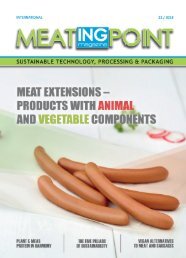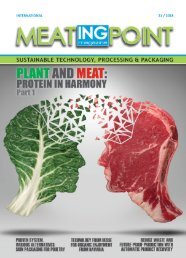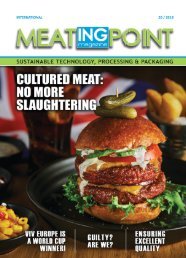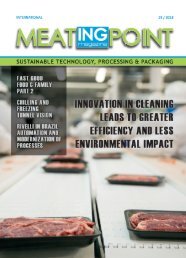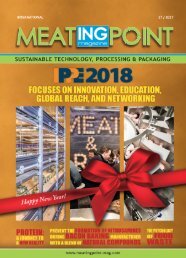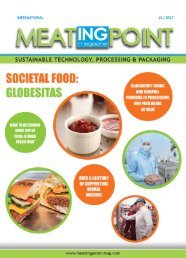MEATing POINT Magazine: #08/ 2016
You also want an ePaper? Increase the reach of your titles
YUMPU automatically turns print PDFs into web optimized ePapers that Google loves.
TRENDS<br />
Are Natural and Organic Foods<br />
Environmentally Sustainable?<br />
by Henk Hoogenkamp<br />
The emerging young American generation<br />
increasingly rejects artificial dyes,<br />
flavourings, preservatives and GMO,<br />
and demand food formulated with ingredients<br />
they recognise and are, preferably, of natural<br />
origin. Sales of many legacy or mainstream<br />
brands known to make processed food with<br />
artificial ingredients and additives have<br />
suffered, while many startup entrepreneurial<br />
natural-food companies have grown. It<br />
seems the bigger the food company; the<br />
fewer consumers trust it.<br />
It has been said that food companies turn<br />
additives and ingredients into food products.<br />
Food and ingredients that give the impression<br />
that they are “natural” and have not been<br />
processed too harshly are of great appeal<br />
to consumers. There is little doubt that the<br />
big American food companies are in the<br />
midst of a public relation crisis. The prevailing<br />
sentiment of the Millennial consumer is that<br />
their mental picture of hyper-processed<br />
robotic-made food is not in sync with the<br />
expectations of their evolving lifestyles, and<br />
this provokes fears about the true composition<br />
of these products. In other words, modern<br />
consumers are increasingly approaching<br />
processed foods with a skeptical eye. It should<br />
also be said that the perceived naturalness<br />
is often synonymous with premiumisation,<br />
attracting customers who have the means<br />
to afford these food products.<br />
Consumers perceive foods with any “freefrom”<br />
claim to be both healthier and less<br />
processed. Although the fear of artificial<br />
dyes and preservatives lacks scientific basis,<br />
consumers have been pushing to have these<br />
eliminated from the ingredient line-up.<br />
The large food establishments are working<br />
overtime to reformulate and are trying to<br />
get their lost market share back. It is not<br />
easy to find acceptable alternatives and<br />
for some legacy food companies, it is even<br />
frustrating that after years of technological<br />
advances to make packaged food cheaper,<br />
more flavourful and longer lasting the<br />
pendulum is now swinging back. A deja-vu<br />
of the good old times.<br />
What Defines “Natural Food”?<br />
The greatest downside for natural and<br />
or organic food products is its lack of a<br />
regulatory definition. “Natural” or “Organic”<br />
brands can be especially weak when the<br />
products contain “non-natural” additives and<br />
ingredients, including traces of GMOs. Even<br />
the US Food and Drug Administration have<br />
a rather weak and non-binding description<br />
of a natural food product.<br />
The current policy for the term “natural”<br />
on food labels is vague and leads to<br />
misinterpretation, and misuse of the term.<br />
Generally speaking, it will be difficult to<br />
categorise foods as “natural” based on the<br />
degree of processing. If he definition of<br />
“natural” is limited to unprocessed foods,<br />
very few foods will be labeled “natural”.<br />
It won’t be easy for the FDA to define “natural”<br />
–a much-used ambiguous marketing term.<br />
Consumers often confuse the terms “natural”<br />
and “healthy.” “Natural food” makes the<br />
consumer believe there are no hormones,<br />
antibiotics, chemicals, GMO and synthetic<br />
vitamins, or GM-derived enzymes. However,<br />
with the current legislation in hand, no<br />
guarantee is given. Whatever the definition<br />
chosen, the term “natural” should avoid any<br />
misinterpretation.<br />
Although to date the terms “natural food”<br />
and “clean label” have no legal definition, an<br />
increasing number of new food introductions<br />
use these expressions and tout recognisable<br />
authentic ingredients that sound natural<br />
and healthy.<br />
The “free-from” category is continuing to<br />
grow globally, including an increase in<br />
interest in GMO-free or non-GMO foods.<br />
Especially in the US, the GM-tide seems<br />
to have changed in recent years with many<br />
premium product launches featuring GMOfree<br />
claims.<br />
Consumers see “natural or organic food”<br />
as good and “processed food” as bad. The<br />
“clean eating” trend has inspired a back<br />
to basics approach in food development.<br />
“Free-from” and “flexitarian” options lead the<br />
way and existing products are upgraded to<br />
meet the new market demands for healthy<br />
and tasty food. An increasing number<br />
issue 8 | www.meatingpoint-mag.com<br />
35




